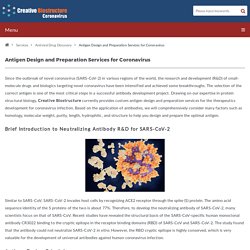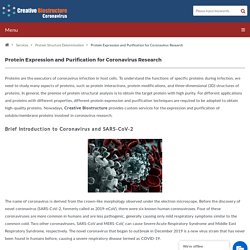

Molecular Docking for the Antiviral Drug Discovery of Coronavirus. Obtaining the structural information of the complex of an individual protein with other molecules (such as proteins, nucleic acids, and small molecules) can help understand the mechanism underlying such interaction, which is significant for drug discovery and development. However, it is relatively difficult and costly to obtain three-dimensional (3D) complex structures through experimental methods such as X-ray crystallography or NMR spectroscopy. Nowadays, Creative Biostructure not only provides experimental techniques for structure determination, but also exploit computational docking methods to predict the 3D structures of these interacting partners to support the development of antiviral drugs against coronavirus infection.
Brief Introduction to Molecular Docking. Antigen Design and Preparation Services for Coronavirus. Since the outbreak of novel coronavirus (SARS-CoV-2) in various regions of the world, the research and development (R&D) of small-molecule drugs and biologics targeting novel coronavirus have been intensified and achieved some breakthroughs.

The selection of the correct antigen is one of the most critical steps in a successful antibody development project. Drawing on our expertise in protein structural biology, Creative Biostructure currently provides custom antigen design and preparation services for the therapeutics development for coronavirus infection. Protein Structure Analysis Using Single Particle Cryo-EM for Coronavirus Research. In recent years, with the advancement of electronic detectors, algorithms and other crucial factors, electron microscopy (EM) technology has been increasingly utilized to study the ultrastructure of macromolecules, cells and tissues. Protein NMR Spectroscopy Services for Coronavirus Research.
NMR spectroscopy is a mainstream approach for analyzing the structure of biological macromolecules, especially structural analysis of small proteins.

This is a non-destructive method that provides chemical structure and kinetic information with atomic resolution. NMR spectroscopy is also suitable for studying molecular interactions under approximately physiological conditions, especially for investigating low- transient and low-affinity complexes. It can provide information on protein interaction interfaces, complex structures, and the dynamics of protein recognition processes. As a professional supplier of structural biology contract services, Creative Biostructure offers high-quality protein NMR spectroscopy services for your research on coronavirus infection. X-ray Crystallography Services for Coronavirus Research. A new highly pathogenic coronavirus (SARS-CoV-2, provisionally named 2019-nCoV) has swept the world since December 2019.

The key to responding to this outbreak is to understand the pathogenic mechanism of the virus. Our understanding of the viral infection process at the molecular and atomic levels depends on the ability to map the structural details of individual biological macromolecules and their interactions with each other and with small molecules. Protein Expression and Purification for Coronavirus Research. Proteins are the executors of coronavirus infection in host cells.

To understand the functions of specific proteins during infection, we need to study many aspects of proteins, such as protein interactions, protein modifications, and three-dimensional (3D) structures of proteins. In general, the premise of protein structural analysis is to obtain the target protein with high purity. For different applications and proteins with different properties, different protein expression and purification techniques are required to be adopted to obtain high-quality proteins. Protein Structure Determination for Coronavirus Research. Determining the three-dimensional (3D) structure of proteins is critical for understanding the mechanism of coronavirus infection, discovering potential drug targets and structure-based drug design.

Rapid advances in methodologies for protein expression and purification have made it easy to obtain enough quantities of proteins for structural studies. In addition, many breakthroughs have been made in X-ray crystallography, nuclear magnetic resonance (NMR) spectroscopy, and electron microscopy (EM) techniques related to protein structure analysis. As a professional structural biology service supplier, Creative Biostructure can offer a range of services for the structure determination of viral structural proteins/non-structural proteins, host proteins, antigen-antibody complexes, etc., using our three established structural biology technology platforms. SARS-CoV-2 and COVID-19.
Since December 2019, multiple cases of pneumonia with unknown etiology have been found in Wuhan, China for the first time.

The World Health Organization (WHO) eventually terms the pneumonia as Coronavirus Disease 2019 (COVID-19), and the novel coronavirus causing the outbreak is named as Severe Acute Respiratory Syndrome Coronavirus 2 (SARS-CoV-2) by International Committee on Taxonomy of Viruses (ICTV). COVID-19 has spread to all provinces in China and many other countries. As a leading supplier in the field of biopharmaceuticals, Creative Biostructure has established an advanced COVID-19 discovery platform with our expertise in structural biology, which can provide a wide range of contract research services involved in structure-based basic research, antiviral drug discovery, and vaccine development to help combat SARS-CoV-2 outbreak. ADMET Modeling and Profiling for Antiviral Drug Discovery of Coronavirus. A number of computational methods have been used in various aspects of drug discovery and development.

In recent decades, in silico ADMET (absorption, distribution, metabolism, excretion, and toxicity) modeling as a rational drug design tool has received extensive attention from pharmaceutical scientists and many ADMET-related prediction models have been developed. The low-cost and high-throughput characteristics of these models allow for a more simplified drug development process in which the drug accessibility of compounds can be predicted, and the identification of hits and structural optimization can be guided. Lead Optimization for the Antiviral Drug Discovery of Coronavirus. The outbreak of novel coronavirus (SARS-CoV-2, formerly known as 2019-nCoV) has drawn global attention, prompting the urgent need to find specific and broad-spectrum antiviral drugs.

With years of experience in structure-based drug design (SBDD), Creative Biostructure combines multidisciplinary drug discovery expertise to provide lead optimization services for coronavirus infection to support the discovery of effective preclinical antiviral drug candidates. Importance of Lead Optimization in Drug Discovery Once the most promising hit series is identified through the efforts of hit to lead, the lead optimization phase of drug discovery will be entered. Lead optimization is a crucial process for finalizing preclinical drug candidates. It is a sophisticated iterative stage in drug discovery and development. Hit to Lead for the Antiviral Drug Discovery of Coronavirus. At present, the drug research for treating Coronavirus Disease 2019 (COVID-19) has just started, and there is a lack of selective therapeutic drugs in clinical practice.

It is urgent to find and develop new treatment methods and drugs. In the face of urgent outbreaks, it is an efficient strategy to screen potential drug candidates from old drugs that are already on the market or from active molecules in clinical trials. Considering the threat of coronavirus infection to humans, we should not only actively seek specific antiviral drugs, but also promote the development of new broad-spectrum anti-coronavirus drugs.
Virtual Screening for the Antiviral Drug Discovery of Coronavirus. There are currently no approved antiviral drugs for treating coronavirus infections.

In the face of an acute outbreak, we hope to adopt a more efficient approach to develop antiviral drugs. There are two main methods for drug screening, including high-throughput screening (HTS) and virtual screening. The HTS method realizes automatic operation and sensitive detection, but the positive rate is low (less than 1/10000), thus the cost is relatively high. However, the positive rate of high-throughput virtual screening is generally around 5%-20%. And the results of virtual screening can be combined with experimental screening to complement each other. Application of Virtual Screening in Antiviral Drug Discovery Once the crystal structure of the viral protein (potential drug target) is obtained, we can use virtual screening technology to screen preclinical candidate drugs. Figure 1. High-throughput Screening (HTS) for the Antiviral Drug Discovery of Coronavirus.
The outbreak of novel coronavirus, the first coronavirus to cause a global pandemic, has forced an acceleration in the development of antiviral drugs against the virus. Creative Biostructure is a professional contract research organization in the field of structural biology. With years of experience in structure-based preclinical drug discovery, we currently offer custom high-throughput antiviral drug screening services in the form of 96-well and 384-well plates. Our biochemical and cell-based high-throughput screening (HTS) technology enables the efficient screening of preclinical candidates for antiviral drug discovery of coronavirus from high-content compound libraries. Fragment-based Drug Discovery (FBDD) for the Antiviral Drug Discovery of Coronavirus. With the SARS-CoV-2 (novel coronavirus, formerly known as 2019-nCoV) spreads around the world, scientists are speeding up the search for drugs that can treat COVID-19, a disease caused by the virus.
Molecular Dynamics Simulation for the Antiviral Drug Discovery of Coronavirus. Molecular dynamics (MD) simulation is an in-silico simulation technique applied to study the physical movements of atoms and molecules. It enables one to use the laws of physics to predict the time-dependent evolution of interacting particle systems. In this approach, atoms and molecules are allowed to interact within a given period of time, thus giving a view of the dynamic evolution of the system. The static models generated by X-ray crystallography, NMR spectroscopy, and homology modeling provide a basic three-dimensional (3D) structural model for biomolecular molecules, while MD simulations can offer atomic-level information about the conformational changes and binding thermodynamics of biomolecular molecules under predetermined physiological conditions.
Brief Introduction to Coronavirus and SARS-CoV-2 Infection Novel coronavirus infection (COVID-19) has spread to all parts of the world since the first case was reported in Wuhan, China in 2019. Figure 1. X-ray Crystallography Services for Coronavirus Research. Microscale Thermophoresis (MST) for Coronavirus Research. Saturation Transfer Differences (STD) NMR for Coronavirus Research.
Fluorescence Resonance Energy Transfer (FRET) Assay for Coronavirus Research. Interactions between biological macromolecules regulate various biological processes. Many molecular biology and biochemistry methods have been developed to detect this interaction, such as pull-down assay, co-immunoprecipitation (Co-IP), yeast two-hybrid analysis, surface plasmon resonance (SPR) and isothermal titration calorimetry (ITC).
However, fluorescence resonance energy transfer (FRET) technology has gained great popularity due to its ability to detect interactions with extremely high spatiotemporal resolution in physiological conditions in a non-invasive manner. Isothermal Titration Calorimetry (ITC) for Coronavirus Research. Isothermal titration calorimetry (ITC) is widely used to detect the affinity and enthalpy of interactions between proteins and/or other molecules. Bio-layer Interferometry (BLI) Technology for Coronavirus Research. Creative Biostructure provides comprehensive services for the study on the interaction of biological macromolecules such as proteins involved in coronavirus research.
Similar to surface plasmon resonance (SPR), bio-layer interferometry (BLI) is also a label-free binding technology that measures the binding kinetics of biomolecular interactions in real time. Brief Introduction to Bio-layer Interferometry (BLI) BLI is an optical technique that can measure the binding kinetics and affinity of biological macromolecule interactions through analyzing interference patterns of light reflected from the biosensor tip surface.
In a BLI experiment, a biosensor tip is exposed to buffer conditions and light and then served as a reference. The remaining tips are exposed to experimental conditions. Figure 1. Surface Plasmon Resonance (SPR) for Coronavirus Research. Single Particle Cryo-EM Data Analysis for Coronavirus Research. X-ray Diffraction Data Collection for Coronavirus Research.